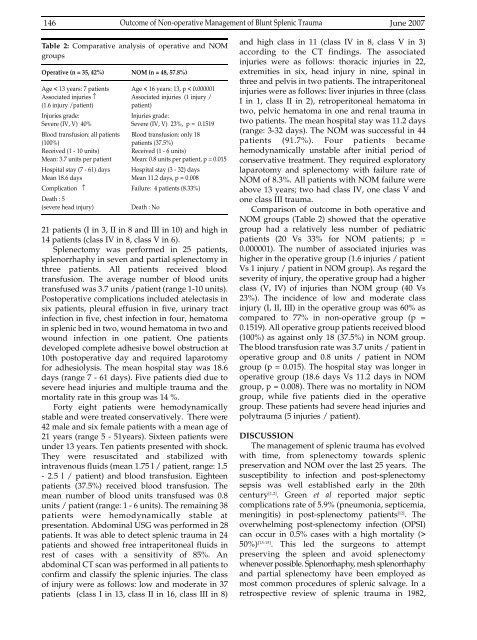Vol 39 # 2 June 2007 - Kma.org.kw
Vol 39 # 2 June 2007 - Kma.org.kw
Vol 39 # 2 June 2007 - Kma.org.kw
- No tags were found...
You also want an ePaper? Increase the reach of your titles
YUMPU automatically turns print PDFs into web optimized ePapers that Google loves.
146Outcome of Non-operative Management of Blunt Splenic Trauma <strong>June</strong> <strong>2007</strong>Table 2: Comparative analysis of operative and NOMgroupsOperative (n = 35, 42%) NOM (n = 48, 57.8%)Age < 13 years: 7 patients Age < 16 years: 13, p < 0.000001Associated injuries ↑ Associated injuries (1 injury /(1.6 injury /patient) patient)Injuries grade:Injuries grade:Severe (IV, V) 40% Severe (IV, V) 23%, p = 0.1519Blood transfusion: all patients Blood transfusion: only 18(100%) patients (37.5%)Received (1 - 10 units)Received (1 - 6 units)Mean: 3.7 units per patient Mean: 0.8 units per patient, p = 0.015Hospital stay (7 - 61) days Hospital stay (3 - 32) daysMean 18.6 days Mean 11.2 days, p = 0.008Complication ↑ Failure: 4 patients (8.33%)Death : 5(severe head injury)Death : No21 patients (I in 3, II in 8 and III in 10) and high in14 patients (class IV in 8, class V in 6).Splenectomy was performed in 25 patients,splenorrhaphy in seven and partial splenectomy int h ree patients. All patients received bloodtransfusion. The average number of blood unitstransfused was 3.7 units /patient (range 1-10 units).Postoperative complications included atelectasis insix patients, pleural effusion in five, urinary tractinfection in five, chest infection in four, hematomain splenic bed in two, wound hematoma in two andwound infection in one patient. One patientsdeveloped complete adhesive bowel obstruction at10th postoperative day and required laparotomyfor adhesiolysis. The mean hospital stay was 18.6days (range 7 - 61 days). Five patients died due tosevere head injuries and multiple trauma and themortality rate in this group was 14 %.Forty eight patients were hemodynamicallystable and were treated conservatively. There were42 male and six female patients with a mean age of21 years (range 5 - 51years). Sixteen patients wereunder 13 years. Ten patients presented with shock.They were resuscitated and stabilized withintravenous fluids (mean 1.75 l / patient, range: 1.5- 2.5 l / patient) and blood transfusion. Eighteenpatients (37.5%) received blood transfusion. Themean number of blood units transfused was 0.8units / patient (range: 1 - 6 units). The remaining 38patients were hemodynamically stable atpresentation. Abdominal USG was performed in 28patients. It was able to detect splenic trauma in 24patients and showed free intraperitoneal fluids inrest of cases with a sensitivity of 85%. A nabdominal CT scan was performed in all patients toconfirm and classify the splenic injuries. The classof injury were as follows: low and moderate in 37patients (class I in 13, class II in 16, class III in 8)and high class in 11 (class IV in 8, class V in 3)a c c o rding to the CT findings. The associatedinjuries were as follows: thoracic injuries in 22,extremities in six, head injury in nine, spinal int h ree and pelvis in two patients. The intraperitonealinjuries were as follows: liver injuries in three (classI in 1, class II in 2), retroperitoneal hematoma intwo, pelvic hematoma in one and renal trauma intwo patients. The mean hospital stay was 11.2 days(range: 3-32 days). The NOM was successful in 44patients (91.7%). Four patients becamehemodynamically unstable after initial period ofconservative treatment. They required exploratorylaparotomy and splenectomy with failure rate ofNOM of 8.3%. All patients with NOM failure wereabove 13 years; two had class IV, one class V andone class III trauma.Comparison of outcome in both operative andNOM groups (Table 2) showed that the operativegroup had a relatively less number of pediatricpatients (20 Vs 33% for NOM patients; p =0.000001). The number of associated injuries washigher in the operative group (1.6 injuries / patientVs 1 injury / patient in NOM group). As regard theseverity of injury, the operative group had a higherclass (V, IV) of injuries than NOM group (40 Vs23%). The incidence of low and moderate classinjury (I, II, III) in the operative group was 60% ascompared to 77% in non-operative group (p =0.1519). All operative group patients received blood(100%) as against only 18 (37.5%) in NOM group.The blood transfusion rate was 3.7 units / patient inoperative group and 0.8 units / patient in NOMgroup (p = 0.015). The hospital stay was longer inoperative group (18.6 days Vs 11.2 days in NOMgroup, p = 0.008). There was no mortality in NOMgroup, while five patients died in the operativegroup. These patients had severe head injuries andpolytrauma (5 injuries / patient).DISCUSSIONThe management of splenic trauma has evolvedwith time, from splenectomy towards splenicpreservation and NOM over the last 25 years. Thesusceptibility to infection and post-splenectomysepsis was well established early in the 20thc e n t u r y [ 1 , 2 ] . Green et al reported major septiccomplications rate of 5.9% (pneumonia, septicemia,meningitis) in post-splenectomy patients [ 1 2 ] . Theoverwhelming post-splenectomy infection (OPSI)can occur in 0.5% cases with a high mortality (>5 0 % ) [ 1 3 - 1 5 ] . This led the surgeons to attemptp reserving the spleen and avoid splenectomywhenever possible. Splenorrh a p h y, mesh splenorrh a p h yand partial splenectomy have been employed asmost common procedures of splenic salvage. In aretrospective review of splenic trauma in 1982,
















